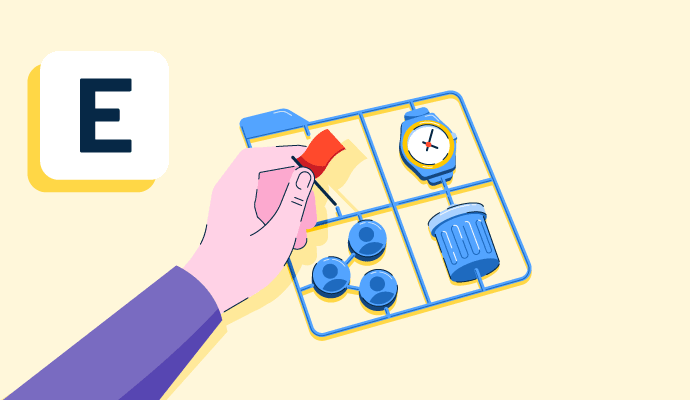What is the Eisenhower Matrix?
The Eisenhower Matrix is a four-quadrant prioritization method for structuring tasks by importance and urgency. Using this method, individuals and businesses adjust their to-do lists and schedule tasks using two criteria.
Companies harness the power of task management software to coordinate individual tasks and daily to-do lists. Task prioritization within the Eisenhower Matrix allows teams to keep track of their to-dos with better productivity and efficiency.
History of the Eisenhower Matrix
34th United States President and World War II five-star general, Dwight David “Ike” Eisenhower, developed the concept behind the Eisenhower Matrix. After serving as President, he delivered a speech in 1954, quoting an unnamed university president: “I have two kinds of problems, the urgent and the important. The urgent are not important, and the important are never urgent.”
Decades later, Stephen Covey, author of The 7 Habits of Highly Effective People, repackaged Eisenhower’s insights from his speech into a four-quadrant matrix now known as The Eisenhower Matrix. People also refer to it as the Eisenhower Box, the Eisenhower Method, and the Urgent-Important Matrix.
Types of Eisenhower Matrix tasks
The Eisenhower Matrix uses two criteria to categorize tasks: urgency and importance. Although the words might seem similar, the difference in definitions is crucial when using this method to prioritize tasks.
- Urgent tasks require immediate attention, and there are clear consequences for not doing so. For example, responding to an upset client or resolving malfunctioning coding issues count as urgent tasks.
- Important tasks achieve goals or align with values. In most instances, they require careful consideration and planning because what’s important to one person may not be to another, as these tasks are often subjective. Not all important tasks are urgent. Planning steps leading to a promotion and attending training events for professional growth are important tasks.
The four quadrants of the Eisenhower Matrix
Understanding what each quadrant means and how to handle the tasks in each of the four quadrants is essential. Below is a breakdown of each quadrant, along with ways to approach them.
- Urgent and important: People sometimes refer to this quadrant as the do quadrant, meaning individuals should immediately attend to any tasks that fall into this category. Urgent and important tasks are time-sensitive, have clear consequences, and significantly affect everyone involved with these actions.
- Important and not urgent: Quadrant two is the schedule quadrant. These tasks affect long-term goals, but they can be done at a later date or serve as part of a continuous process. Tasks in this category are not time-sensitive, but professionals should still be mindful of relevant due dates and timelines.
- Urgent and not important: People sometimes refer to this quadrant as the delegate quadrant. Tasks in this category need to be completed immediately, but since they’re not significant, experts recommend delegating them to other team members when possible.
- Not Urgent and Not Important: Remaining tasks that don’t fit into one of the previous three quadrants fall into the delete category. Items that aren’t urgent or important can be significant time wasters, and individuals should evaluate whether these tasks truly need to be done.
Benefits of the Eisenhower Matrix
Using the Eisenhower Matrix makes professional life easier and more organized. Businesses that rely on this process may leverage these advantages.
- Simple user interface. Unlike some complex time management strategies, the Eisenhower Matrix is easy to approach. It takes little effort to start using it and doesn’t require prior knowledge or additional tools.
- Applications for any role, industry, or tenure. The Eisenhower Matrix is valuable for any junior or senior position. It also works well for individuals across industries since urgency and importance are considerations for all types of work.
- Better-informed decisions. Instead of merely emphasizing completing an entire to-do list in a set period, the Eisenhower Matrix forces individuals to consider the essence of each task. This enables teams to make better decisions about how they spend their time, which helps with boundary-setting and growth-oriented planning.
- Improved efficiency. When appropriately implemented, the Eisenhower Matrix can improve efficiency over time as tasks fall off their to-do list as per the plan. The Eisenhower Matrix can also help workers feel like they have control of their time, which is empowering.
Eisenhower Matrix best practices
To get the most out of the Eisenhower Matrix, companies use the following best practices and tips for implementation.
- Set quadrant limits. Individuals may use some quadrants more than others. It’s beneficial to set approximate limits for each quadrant to avoid placing too many tasks in one box.
- Separate personal and professional tasks. As tempting as it is to combine all tasks and sort them using one Eisenhower Matrix, it’s best to create different matrices. Separating tasks prevents overlapping commitments and clarifies action items that need to be accomplished during the workday or outside working hours.
- Pair it with time blocking. Sorting tasks using the Eisenhower Matrix helps individuals sort their to-do lists, but it doesn’t help determine when the tasks get done. For maximum effectiveness, the Eisenhower Matrix can be paired with time blocking.
Need to create more time in the workday? Figure out how to reclaim your time with workflow automation to knock even more tasks off the to-do list.

Alyssa Towns
Alyssa Towns works in communications and change management and is a freelance writer for G2. She mainly writes SaaS, productivity, and career-adjacent content. In her spare time, Alyssa is either enjoying a new restaurant with her husband, playing with her Bengal cats Yeti and Yowie, adventuring outdoors, or reading a book from her TBR list.







-1.png)
